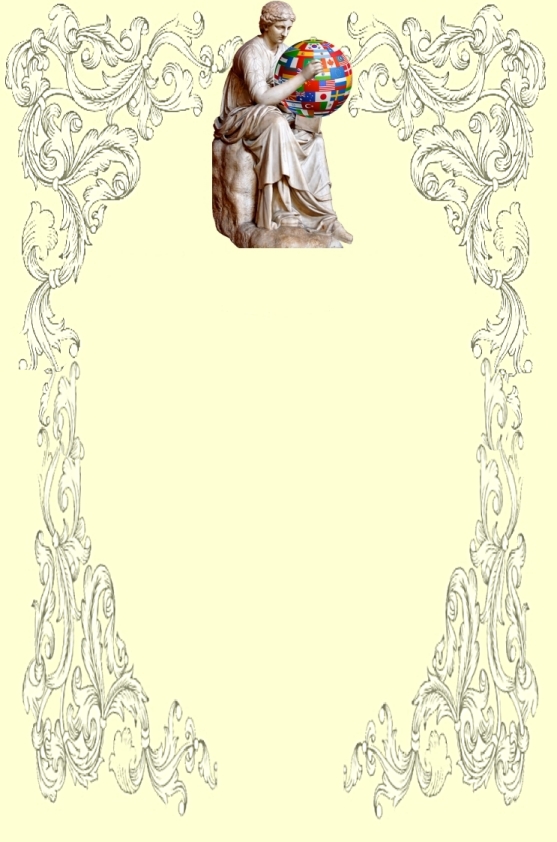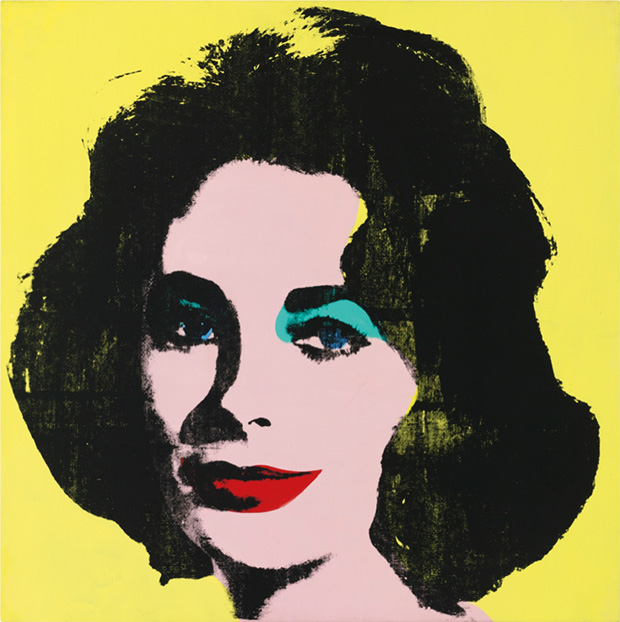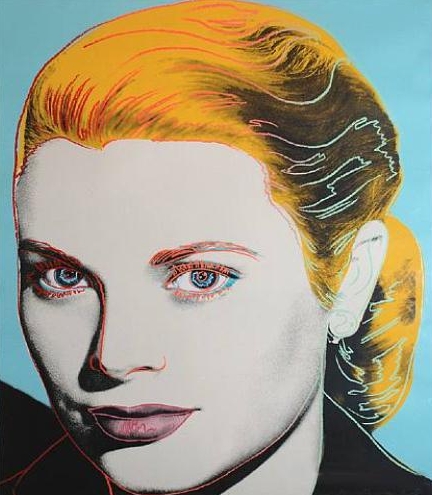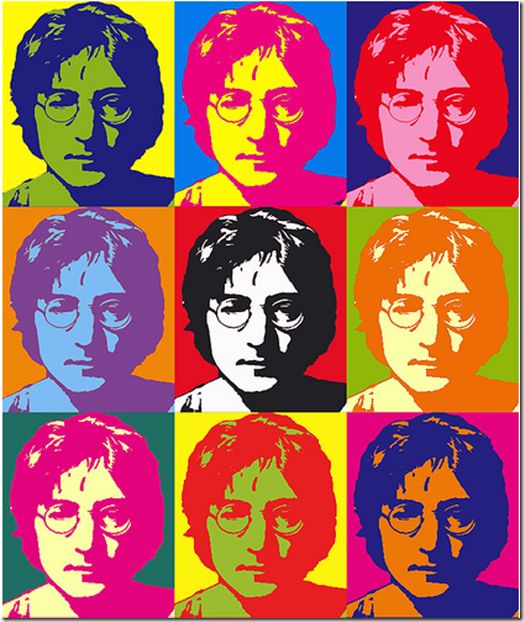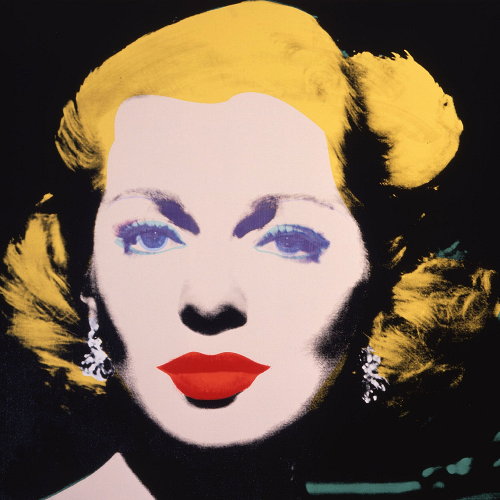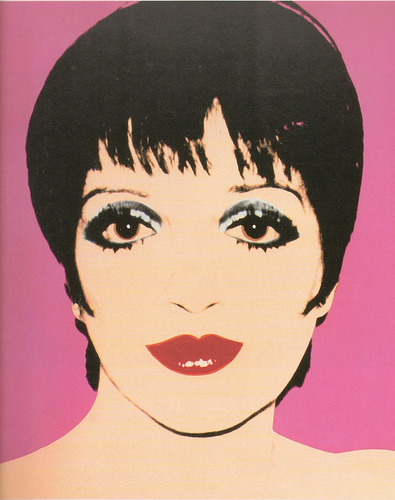ANDY WARHOL
Yellow colored Liz
ANDY WARHOL
Grace Kelly
ANDY WARHOL
John Lennon
ANDY WARHOL
Lana Turner
ANDY WARHOL
Lisa Minelli
ANDY WARHOL
Marilyn invitation
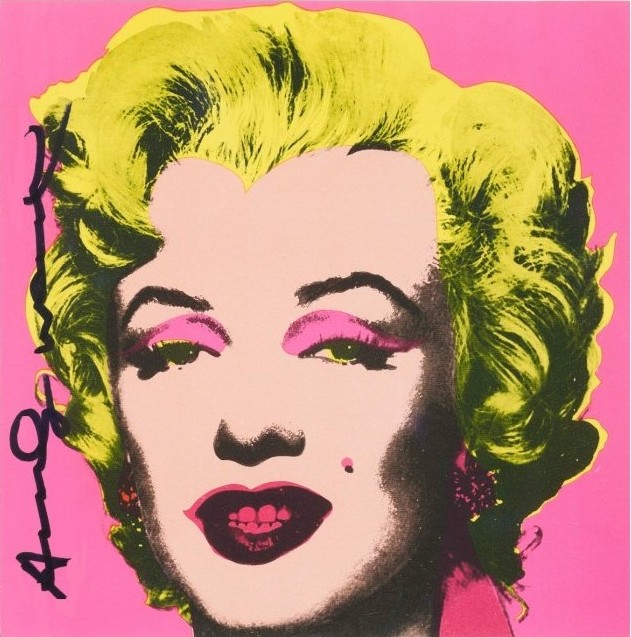
ANDY WARHOL
SEL-PORTRAIT
1928 - 1987
Biography
Andy was the third child born to Czechoslovakian
immigrant parents, Ondrej and Ulja (Julia)
Warhola, in a working class neighborhood
of Pittsburgh. He had two older brothers,
John and Paul. As a child, Andy was smart
and creative. His mother, a casual artist
herself, encouraged his artistic urges by
giving him his first camera at nine years
old. Warhol was known to suffer from a nervous
disorder that would frequently keep him at
home, and, during these long periods, he
would listen to the radio and collect pictures
of movie stars around his bed. It was this
exposure to current events at a young age
that he later said shaped his obsession with
pop culture and celebrities. When he was
14, his father passed away, leaving the family
money to be specifically used towards higher
learning for one of the boys. It was decided
by the family that Andy would benefit the
most from a college education.
After graduating from high school at the
age of 16, in 1945, Warhol attended Carnegie
Institute of Technology (now Carnegie Mellon
University), where he received formal training
in pictorial design. Shortly after graduating,
in 1949, he moved to New York City, where
he worked as a commercial illustrator. His
first project was for Glamour magazine for
an article entitled, "Success is a Job
in New York." Throughout the 1950s Warhol
continued his successful career in commercial
illustration, working for several well-known
magazines, such as Vogue, Harper's Bazaar
and The New Yorker. He also produced advertising
and window displays for local New York retailers.
His work with I. Miller & Sons, for which
his whimsical blotted line advertisements
were particularly noticed, gained him some
local notoriety, even winning several awards
from the Art Director's Club and the American
Institute of Graphic Arts.
In the early 1950s, Andy shortened his name
from Warhola to Warhol, and decided to strike
out on his own as a serious artist. His experience
and expertise in commercial art, combined
with his immersion in American popular culture,
influenced his most notable work. In 1952,
he exhibited Fifteen Drawings Based on the
Writings of Truman Capote in his first individual
show at the Hugo Gallery in New York. While
exhibiting work in several venues around
New York City, he most notably exhibited
at MoMA, where he participated in his first
group show in 1956. Warhol took notice of
new emerging artists, greatly admiring the
work of Robert Rauschenberg and Jasper Johns,
which inspired him to expand his own artistic
experimentation.
In 1960, Warhol began using advertisements
and comic strips in his paintings. These
works, examples of early Pop art, were characterized
by more expressive and painterly styles that
included clearly recognizable brushstrokes,
and were loosely influenced by Abstract Expressionism.
However, subsequent works, such his Brillo
Boxes (1964), would mark a direct rebellion
against Abstract Expressionism, by almost
completely removing any evidence of the artist's
hand.
Andy Warhol worked across many media as a
painter, printmaker, illustrator, filmmaker
and writer. In September 1960, after moving
to a townhouse at 1342 Lexington Avenue,
on the Upper East Side of Manhattan, he began
his most prolific period. From having no
dedicated studio space in his previous apartment,
where he lived with his mother, he now had
plenty of room to work. In 1962 he offered
the Department of Real Estate $150 a month
to rent a nearby obsolete fire house on East
87th Street. He was granted permission and
used this space in conjunction with his Lexington
Avenue space until 1964.
Continuing with the theme of advertisements
and comic strips, his paintings throughout
the early part of the 1960s were based primarily
on illustrated images from printed media
and graphic design. To create his large-scale
graphic canvases, Warhol used an opaque projector
to enlarge the images onto a large canvas
on the wall. Then, working freehand, he would
trace the image with paint directly onto
the canvas without a pencil tracing underneath.
As a result, Warhol's works from early 1961
are generally more painterly.
Late in 1961, Warhol started on his Campbell's
Soup Can paintings. The series employed many
different techniques, but most were created
by projecting source images on to canvas,
tracing them with a pencil, and then applying
paint. In this way Warhol removed most signs
of the artist's hand.
In 1962 Warhol started to explore silkscreening.
This stencil process involved transferring
an image on to a porous screen, then applying
paint or ink with a rubber squeegee. This
marked another means of painting while removing
traces of his hand; like the stencil processes
he had used to create the Campbell's Soup
Can pictures, this also enabled him to repeat
the motif multiple times across the same
image, producing a serial image suggestive
of mass production. Often, he would first
set down a layer of colors which would compliment
the stencilled image after it was applied.
His first silkscreened paintings were based
on the front and back faces of dollar bills,
and he went on to create several series of
images of various consumer goods and commercial
items using this method. He depicted shipping
and handling labels, Coca-Cola bottles, coffee
can labels, Brillo Soap box labels, matchbook
covers, and cars. From autumn 1962 he also
started to produce photo-silkscreen works,
which involved transferring a photographic
image on the porous silkscreens. His first
was Baseball (1962), and those that followed
often employed banal or shocking imagery
derived from tabloid newspaper photographs
of car crashes and civil rights riots, money
and consumer household products.
In 1964 Warhol moved to 231 East 47th Street,
calling it "The Factory." Having
achieved moderate success as an artist by
this point, he was able to employ several
assistants to help him execute his work.
This marked a turning point in his career.
Now, with the help of his assistants, he
could more decisively remove his hand from
the canvas and create repetitive, mass-produced
images that would appear empty of meaning
and beg the question, "What makes art,
art?" This was an idea first introduced
by Marcel Duchamp, whom Warhol admired.
Warhol had a lifelong fascination with Hollywood,
demonstrated by his series of iconic images
of celebrities such as Marilyn Monroe and
Elizabeth Taylor. He also expanded his medium
into installations, most notably at the Stable
Gallery in New York in 1964, replicating
Brillo boxes in their actual size and then
screenprinting their label designs onto blocks
made of plywood.
Wanting to continue his exploration of different
mediums, Warhol began experimenting with
film in 1963. Two years later, after a trip
to Paris for an exhibition of his work, he
announced that he would be retiring from
painting to focus exclusively on film. Although
he never completely followed through with
this intention, he did produce many films,
most starring those whom he called the Warholstars,
an eccentric and eclectic group of friends
who frequented the Factory and were known
for their unconventional lifestyle.
He created approximately 600 films between
1963 and 1976, films ranging in length from
a few minutes to 24 hours. He also developed
a project called The Exploding Plastic Inevitable,
or EPI, in 1967. The EPI was a multi-media
production combining The Velvet Underground
rock band with projections of film, light
and dance, culminating in a sensory experience
of performance art. Warhol had also been
self-publishing artist's books since the
1950s, but his first mass produced book,
Andy Warhol's Index, was published in 1967.
He later published several other books, and
founded Interview Magazine with his friend
Gerard Malanga in 1969. The magazine is dedicated
to celebrities and is still in production
today.
After an attempt on his life in 1968, by
acquaintance and radical feminist, Valerie
Solanas, he decided to distance himself from
his unconventional entourage. This marked
the end of the 1960s Factory scene. Warhol
subsequently sought out companionship in
New York high society, and throughout most
of the 1970s his work consisted of commissioned
portraits derived from printed Polaroid photographs.
The most notable exception to this is his
famous Mao series, which was done as a comment
on President Richard Nixon's visit to China.
Lacking the glamour and commercial appeal
of his earlier portraits, critics saw Warhol
as prostituting his artistic talent, and
viewed this later period as one of decline.
However, Warhol saw financial success as
an important goal. He had made the shift
from commercial artist to business artist.
Ironically, in the late 1970s and 1980s,
Warhol made a return to painting, and produced
works that frequently verged on abstraction.
His Oxidation Painting series, which were
made by urinating on a canvas of copper paint,
echoed the immediacy of the Abstract Expressionists
and the rawness of Jackson Pollock's drip
paintings. By the 1980s, Warhol had regained
much of his critical notoriety, due in part
to his collaboration with Jean-Michel Basquiat
and Francesco Clemente, two much younger
and more cutting-edge artists. In the final
years of Warhol's life, he turned to religious
subjects; his version of Leonardo da Vinci's
Last Supper is particularly renowned. In
these works, Warhol melded the sacred and
the irreverent by juxtaposing enlarged logos
of brands against images of Christ and his
Apostles.
After suffering postoperative complications
from a routine gall bladder procedure, Warhol
died on February 22, 1987. He was buried
in his hometown of Pittsburgh. His memorial
service was held in St. Patrick's Cathedral
in New York City and attended by more than
2,000 people
THE POP ART
Art History General Overview Pop Art is art
made from commercial items and cultural icons
such as product labels, advertisements, and
movie stars. In a way, Pop Art was a reaction
to the seriousness of Abstract Expressionist
Art. Pop Art is meant to be fun. When was
the Pop Art movement? Pop Art began in the
1950s, but became very popular in the 1960s.
It started in the United Kingdom, but became
a true art movement in New York City with
artists like Andy Warhol and Jasper Johns.
What are the characteristics of Pop Art?
Pop Art uses images and icons that are popular
in the modern world. This includes famous
celebrities like movie stars and rock stars,
commercial items like soup cans and soft
drinks, comic books, and any other items
that are popular in the commercial world.
There are a number of ways that artists use
these items to create art such as repeating
the item over and over again, changing the
color or texture of the item, and putting
different items together to make a picture.
Examples of Pop Art Eight Elvises (Andy Warhol)
Eight Elvises uses a picture of Elvis Presley
pulling a pistol out and aiming it at the
viewer like a gunslinger from the Wild West.
The picture of Elvis is repeated eight times.
The repeating pictures get closer together
as they move to the right and overlap each
other giving the picture a feeling of infinity.
This painting sold for over $100 million
in 2009. You can see a picture of this painting
here. Drowning Girl (Roy Lichtenstein) This
painting is made to look like a scene from
a comic book. The girl is drowning and she
yells out "I don't care! I'd rather
sink, than call Brad for help!" The
artist even painted the picture with the
dots that are often seen in the color areas
on comic books. You can see a picture of
this painting here. Three Flags (Jasper Johns)
Jasper Johns painted a number of pictures
of the American Flag. In this picture he
paints three flags on top of each other.
Each flag appears closer to the viewer, but
gets smaller as well. You can see a picture
of this painting here. Famous Pop Art Artists
Keith Haring - This New York artist is famous
for his cartoon like outlined pictures of
people doing different things. His art was
inspired by graffiti. David Hockney - Hockney
is considered one of the most important English
artists of the 20th century. He played a
major role in the development of Pop Art.
Jasper Johns - Jasper is most famous for
his paintings of the American flag. He has
also painted a map of the United States and
another famous painting of just numbers called
Numbers in Color. Roy Lichtenstein - Roy
is known for making art from the inspiration
of comic books. Wayne Thiebaud - Thiebaud
became famous by painting items such as pies,
cakes, lipstick, and toys. One of his most
famous paintings is of three gumball machines
called Three Machines. Andy Warhol - Warhol
is the most famous of the Pop Artists and
played a major role in making the art movement
popular. His painting of Campbell's Soup
cans pushed Pop Art to the front of the art
scene. Interesting Facts about Pop Art There
is a similar sounding type of art called
Op Art. Op Art is art that uses optical illusion
to trick the eye. Some people say that Pop
Art is poking fun at traditional art and
is most closely related to the nonsense art
of Dadaism. Pop Art artists wanted to make
art for the masses. They felt that earlier
art was elitist. The first use of the word
"pop" to describe art was by Scottish
artist Eduardo Paolozzi. "Pop Art"
was then used in 1954 by artist John McHale.
THE POP ART
IN ARTE EST LIBERTAS
MOVEMENTS-ARTISTS
